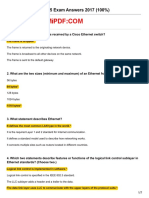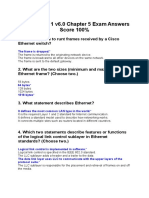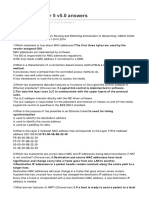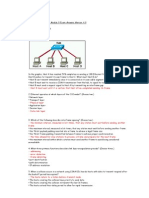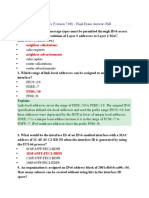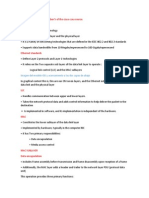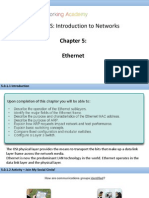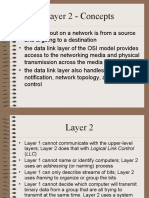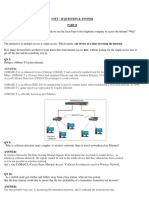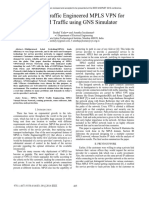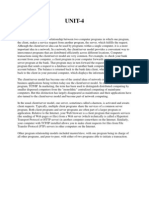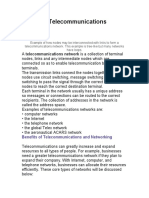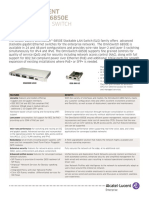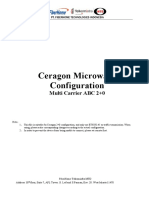Q1.
(a) The Ethernet MAC sublayer has 2 primary responsibilities which are data
encapsulation and Media Access Control (MAC).
(i) Describe the THREE (3) primary functions of data encapsulation.
(6marks)
● Frame delimiting. It is used to identify a group of bits that make up a frame,
synchronization between the transmitting and receiving nodes.
● Addressing. Each header added in the frame contains the physical address
(MAC address) that enables a frame to be delivered to a destination node.
● Error detection. Each Ethernet frame contains a trailer with a cyclic redundancy
check (CRC) of the frame contents.
(ii) Discuss TWO (2) primary functions of Media Access Control.
(4marks)
● Placement and removal of frames from the media. The Media Access Control
takes data frames from the Logical Link Control (LLC) layer and placing them on
the media.
● Media Recovery. The MAC sublayer adds error checking information to the
frames it sends, which the receiver can use to detect if the frame was damaged
or altered during transmission. > Media Recovery. The MAC sublayer is able to
perform initiation of the frame’s transmission and recovery (when there is
transmission failure).
(b) Describe TWO (2) frame forwarding methods available on Cisco switches.
(6 marks)
Store-and-forward switching
● A store-and-forward switch receives the entire frame and computes the
CRC.
● If the CRC is valid, the switch looks up the destination address, which
determines the outgoing interface.
● The frame is then forwarded out the correct port.
Cut-through switching
� ● A cut-through switch forwards the frame before it is entirely received. At a
minimum, the destination address of the frame must be read before the
frame can be forwarded.
● The switch buffers just enough for the frame to read the destination MAC
address so that it can determine to which port to forward the data.
● The switch does not perform any error checking on the frame.
(c) Determine the correct sublayer for the following descriptions.
(6 marks)
Descriptions MAC or LLC?
1. Controls the network interface card through software MACLLC
drivers
2. Works with the upper layers to add application LLC
information for delivery of data to higher level protocols
3. Works with hardware to support bandwidth MAC
requirements and checks errors in the bits sent and
received
4. Controls access to the media through signaling and MAC
physical media standards requirements
5. Supports Ethernet technology by using CSMA/CD or MAC
CSMA/CA
6. Remain relatively independent of physical equipment LLC
Q2. (a) In a Local Area Network, Address Resolution Protocol (ARP) request is a layer 2
broadcast messages. All the devices in the LAN received the ARP request except the
sending device.
(i) What is the purpose of the ARP?
(2marks)
● ARP finds the MAC address of the destination for a given Ethernet link to send
node.> The sender node uses ARP to find the MAC address of the destination for
a given ethernet link.
● ARP determines the destination of MAC address.
�(ii) What is the action taken by a node if the node’s IP address matched the IP address in
the ARP request?
(2marks)
● When a node receives an ARP request and the IP address in the request
matches its own IP address, the node will respond with an ARP reply.
● This reply contains the node’s MAC address.
● The node that sent the ARP request can then update its ARP table with the new
information which will be used for future communications. Thus, the devices on a
network can communicate effectively.
(iii) What happens if no device on the LAN responds to the ARP request?
(2marks)
● The device that sent the ARP request will not be able to resolve the IP address to
a MAC address.
● Thus, the device will no longer to communicate with the intended recipient of the
data packet on the LAN.
● The frame will be dropped if the ARP request is not able to determine the correct
destination.
(iv) Name and explain ONE (1) reason ARP can cause a problem in a network.
(3marks)
● ARP spoofing. The attackers can respond to requests and pretend to be
providers of services.
● When host A requests the MAC address of the default gateway, the host C which
is the attacker replies the ARP request instead of the node.
● Host A will then receive the reply and update its ARP table. It will send packers
destined to the default gateway to the attacker host C.
Q3.(a)Inspect the following MAC addresses; is this a proper MAC address? If no, why?
(i) 77:EE:33:AA:DD (2marks)
● Proper MAC address > Not a proper MAC address because there is only 10
hexadecimal characters when it should be 12 instead.
(ii) 01-34-45-7U-8B-P9 (2marks)
● Not a proper MAC address. MAC address should consist of hexadecimal digits (0-9 and
A-F) only. The ‘U' and 'P’ are invalid hexadecimal digits.
�(iii) FI00:5678.910C (2marks)
● Not a proper MAC address. MAC address should consist of either one of ‘-', ‘:’ or ‘.’ only.
However, the MAC address given applies ‘:’ and '.’.
(b) In Ethernet, different MAC addresses are used for unicast, multicast, and broadcast
communications. Give relevant examples of MAC address used in unicast, multicast, and
broadcast delivery. (6 marks)
Unicast MAC Address
● A unicast MAC address is the unique address used when a frame is sent from a
single transmitting device to a single destination. ++ Only unicast can use the
source address.
● Example of unicast MAC address: 68:17:29:8F:1A:34
Multicast MAC Address
● Multicast address allows a source device to send a packet to a group of devices.
● Example of multicast MAC address: 01-00-5E-00-00-FA
Broadcast MAC Address
● A broadcast packet contains a destination IPv4 address that has all ones in the
host portion indicating that all hosts on that local network will receive and process
the packet.
● Example of broadcast MAC address: FF-FF-FF-FF-FF-FF
(c) Refer to the exhibit. The exhibit shows a small switched network and the contents of
the MAC address table of the switch. PC1 has sent a frame addressed to PC3. What will the
switch do with the frame? (6 marks)
�● When PC1 has sent a frame addressed to PC3, the switch will look at its MAC address
table and see that the MAC address of PC3 (12-34-56-78-9A-BE) is associated with Port
2.
● So, the switch will forward the frame only to Port 2. This action is also known as unicast
forwarding.
● This forwarding method is efficient as it can reduce unnecessary network traffic
compared to a hub, which would broadcast the frame to all ports when using a switch in
a network.
● The MAC address of PC 3 is not included in MAC table of the switch.
● The switch will broadcast / forward the frame to all the ports except the incoming port.




